By Chris Spangler
State officials recently received citizen input on building a roundabout at the intersection of State Highway 106 and Jefferson County Highway N.
A public involvement meeting on the proposed project was held Wednesday, Nov. 8, at the Town of Koshkonong Hall.
Representing the Southwest Region of the Wisconsin Department of Transportation (DOT) were project manager Matthew Lamb and project engineer Tijler DeyMarcos.
“The purpose of this project is to improve safety at this intersection,” DeyMarcos said. “This intersection was identified in the 2019 Locations of Interest Report via the (federal) Highway Safety Improvement Program known as HSIP.”
He reported that from 2013-2018, 13 crashes occurred at that location just east of Fort Atkinson.
“Of those crashes, eight were right-angle crashes all caused by drivers on County N failing the yield to Highway 106 traffic,” DeyMarcos said. “This resulted in three minor injuries and five property damage-only crashes.”
He also shared crash data from 2019-2023.
“Over the current five-year period, there were 12 total crashes. Eight of those were right-angle crashes, once again all caused by drivers on County N failing to yield to the Highway 106 traffic. This resulted in two serious injuries and three minor injuries.
It was concluded that this intersection has a crash pattern of failure to yield,” DeyMarcos explained.
Addressing those concerns, he said, the Bureau of Traffic Operations developed an Intersection Control Valuation Report.
“This report takes into account numerous factors, including traffic forecast, crash history, crash patterns, oversized/overweight vehicle frequency and other environmental factors,” DeyMarcos said, adding that it considered three alternatives: do nothing, install traffic signals or build a roundabout.
He pointed out that doing nothing would not improve safety, while traffic flow did not warrant traffic lights.
“The preferred alternative is to reconstruct the intersection into a single-land roundabout. This should reduce the potential for serious-type crashes, along with providing an operationally efficient intersection where most vehicles are going to be able to get through with only minor delays,” DeyMarcos said.
He shared a graphic indicating conflict points where vehicle paths diverge, merge or cross and which are likely to cause rear-end, sideswipe and right-angle crashes, respectively.
“There are 32 total conflict points at the current intersection. Sixteen of them are crossing,” he said. “For the single-lane roundabout alternative, there are only eight total conflict points and none of them are crossing. This will reduce the potential for serious injury or crashes.”
DeyMarcos said the roundabout effectively removes those crossing conflict points by simply going around them.
Roundabout design
Proposed improvements include reconstructing the intersection into a single-land roundabout and replacing culverts.
DeyMarcos said that asphalt pavement was chosen for the exterior of the intersection to match existing pavement. Concrete will be used for the interior because it typically is easier to use in construction and has been proven to better hold up to heavy truck traffic that might be slowing or stopping at the entrances to the roundabout.
He said islands will not only separate traffic, but also cause it to slow down while entering the roundabout.
“The roundabout is designed to accommodate a multitude of large truck traffic,” he said, citing 40-foot trucks such as a typical U-Haul to 83-foot semi tractor-trailers.
During initial public outreach, he said, the DOT received some suggestions for vehicle accommodations. They include ensuring the roundabout is able to accommodate combines, snowplows, 43-foot grain trucks and lowboys with a 53-foot trailer.
“In summary, this roundabout was designed to accommodate every single vehicle that was mentioned,” DeyMarcos said, cautioning that the design is very preliminary and will be adjusted as input is received and further study is done.
He added, “A DOT Intersection Control Evaluation Report concluded that a roundabout was the only feasible option to boost safety, as it has proven to reduce serious-type injury crashes while preserving an acceptable level of service for traffic flow.”
Detour routes
DeyMarcos said that the Highway 106/N intersection would be closed to through-traffic during the reconstruction. There would be temporary driveway closures during the work, with property owners informed beforehand.
“The reason why we prefer to detour or to close the intersection is that it typically results in a lower bid price and it usually results in a shorter construction time frame,” he said.
State Highway 106 traffic would be detoured along U.S. Highway 12 from Fort Atkinson to Whitewater and then State Highway 59 from Whitewater to Palmyra. County Highway N traffic is anticipated to be detoured on Business State Highway 26 and then State Highway 89 through Fort Atkinson to Highway 12 and then County Highway M to Highway N.
An environmental study is expected to be completed in the summer of 2024, with the complete design study report and roundabout geometrics finalization by that fall. Real-estate acquisition would start in the winter of 2024. Final plans would be completed in the winter of 2026 with construction beginning in the spring of 2027.
“We will be acquiring real estate in the form of temporary and permanent easements to perform grading operations and future maintenance in proposed ditches,” DeyMarcos said.
The pricetag for the roundabout is estimated between $2 million and $4 million, with 90 percent being funded through HSIP and 10 percent through the state.
Public questions and input
Responding to questions from attendees, Lamb said roundabouts in a rural setting usually take about three months to build.
Curt Abendroth remarked that it appeared that the project was based on fewer than two crashes a year.
“The worry is that if we leave the intersection as it is, it could result in more serious injuries or even fatalities in the future because there is that failure to yield,” DeyMarcos replied, explaining that the resulting right-angle crashes are the most dangerous because there is less of a buffer between the driver and striking vehicle.
Lamb added that the DOT has been seeing progressively more serious crashes.
Another attendee asked if speed was studied.
“Most accidents will be in the eastbound traffic and there is a curve there,” he said. “People come around 70, 75 miles an hour and by the time you’ve made your decision to come out (into the intersection), sometimes those cars are upon you very quickly.”
He suggested that were the 45-mph speed limit extended to the intersection, the crash rate might drop about 90 percent.
DeyMarcos replied that speed has been a consideration.
Lamb said that speed studies are based on the 80-percentile traffic speed and that’s what dictates many of the speed limits. In this case, the stretch of road does not warrant 45 mph.
“That’s not going to slow them down,” he said.
Abendroth suggested installing speed bumps along Highway N prior to the Highway 106 intersection to slow down vehicles.
“Speedbumps are usually reserved for very slow speeds, like 25- mph and 30-mph areas. So if you put it on 55, people aren’t going to have enough time to slow down,” Lamb said.
He emphasized that the speed on Highway 106 is not the problem. Rather, the problem is people on Highway N crossing Highway 106.
“(Highway) 106 could be going 100 miles an hour and it wouldn’t matter because N (traffic) is supposed to stop,” Lamb said.
Frankie Fuller asked whether the roundabout will have room or even a dedicated lane for bicycles.
Lamb said that the five-foot-wide shoulders should help provide space. In addition, the roundabout speed limit is 20 to 30 mph max, so bicyclists should be safer that they currently are crossing that intersection.
“Typically, if we were going to accommodate bikes, it would be through specialized paths. Our multi-mobile engineer determined that this intersection isn’t qualified for that, but we can definitely speak to her about that,” Lamb said.
Jefferson County Highway Department operations manager Brian Udovich was in attendance and said that the current county bicycle map does not recommend these routes for bicyclists due to traffic volume and speed and the fact that they are not near recreational trails.
Continuing, another attendee said he favors this change. Not only will the roundabout slow traffic, but large trucks won’t have to stop to turn, he said.
“I wouldn’t put grass in the middle; it will just be a hayfield,” he added, referring to the center island. “I’d rather see through the roundabout.”
Several attendees agreed that the roundabouts along State Highway 26 in Watertown are “the worst” because motorists must turn left to enter and then immediately turn right. The roundabout at State Highway 60 and County Highway F near Ixonia is good for passenger vehicles, but a little small for trucks, they said.
“It makes no sense. (Highway) 106 seems straight; N’s a little goofy,” a man said.
“We have learned a lot over the years. At some of our original roundabouts, we have had to go back and adjust and modify them because, like everything, we learn as we go through. We’re hoping we’ve caught those lessons from others,” Lamb said.
Responding to a question about lighting, he said that that lower-wattage LED bulbs will be used.
“The intent is to gradually increase light as people enter (the roundabout), give them lights so they can see what’s happening and then, as they exit, lower the lighting,” Lamb said.
He said the bottom line of the project is improving safety.
“Usually when we have these projects, there have been a number of fatalities. This is the first one I’ve come across we haven’t had one yet. I really don’t want to see one. If we can address it by eliminating the possibility of having it by removing that accident type, that would be the best,” he said.
“The concern is we can’t control the driver. The roundabout we can use … and it will help force people to slow down.”
For more information, Lamb may be contacted at by email: Matthew.lamb@dot.wi.gov. The project website address is: https://wisconsindot.gov/Pages/projects/by-region/sw/wis106-countyn/default.aspx.
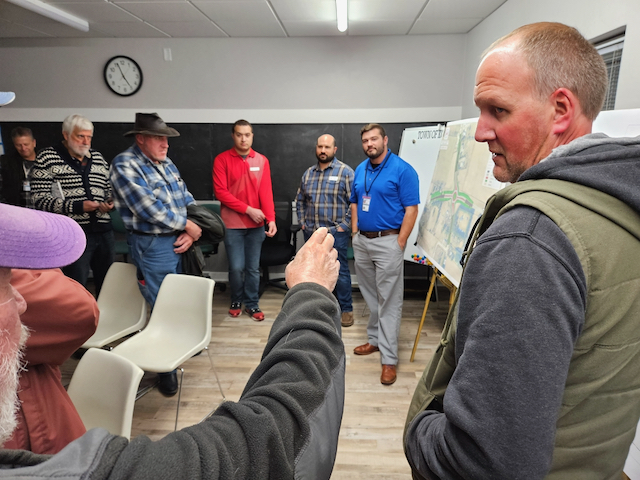
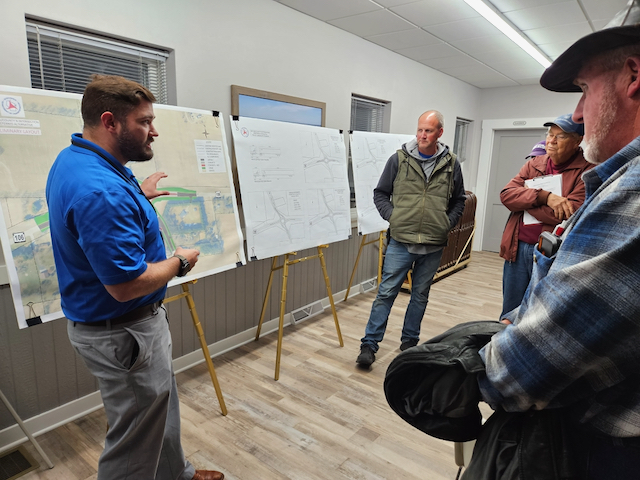
Two photos above: State Department of Transportation officials visit with members of the public prior to a Nov. 8 meeting regarding building a roundabout at the intersection of State Highway 106 and Jefferson County Highway N.
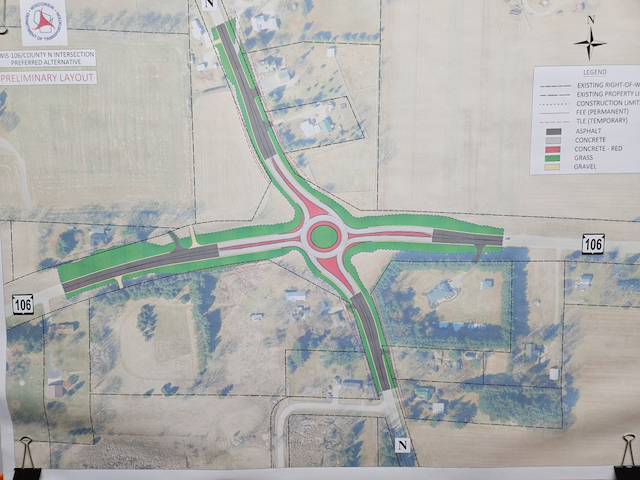
A DOT supplied schematic shows the planned roundabout at the intersection of State Highway 106 and County Highway N in the town of Koshkonong.
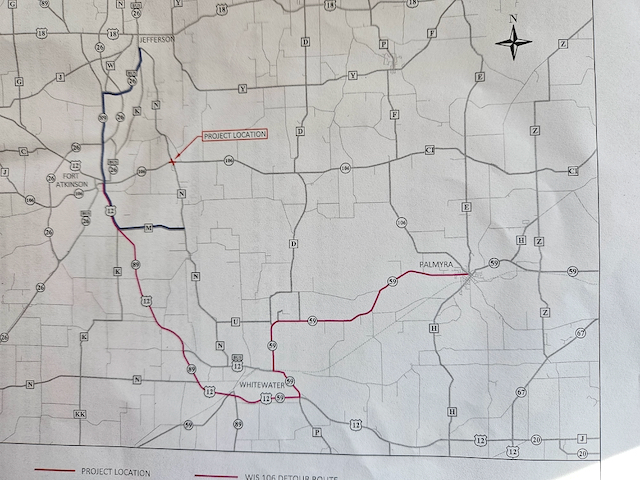
A map supplied by the DOT shows proposed detour routes which will be in place during the planned roundabout’s construction. The routes are marked in red.
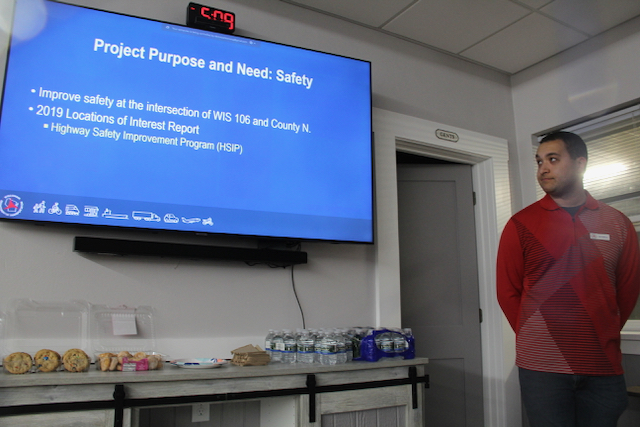
Department of Transportation project engineer Tijler DeyMarcos outlines details of the proposed roundabout.
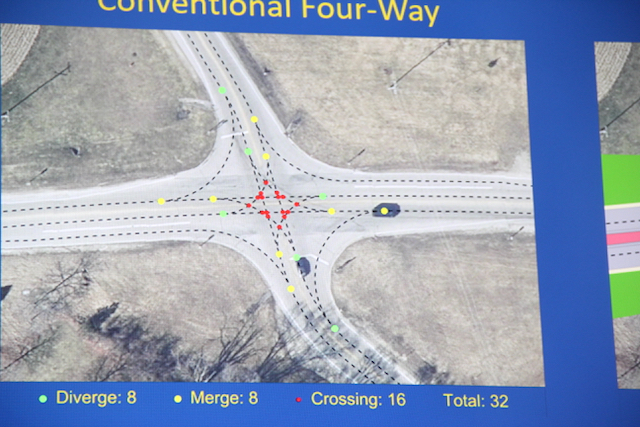
The DOT supplied graphic above shows 32 conflict points at the Highway 106/County N intersection, where vehicle paths diverge, merge or cross and which are likely to cause rear-end, sideswipe and right-angle crashes, respectively. Sixteen of them are crossing conflict points, department official said.
Chris Spangler photos.
This post has already been read 2546 times!